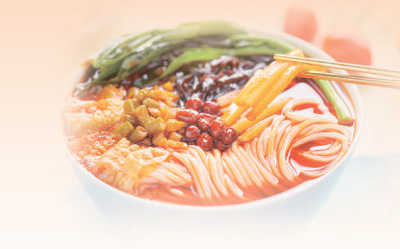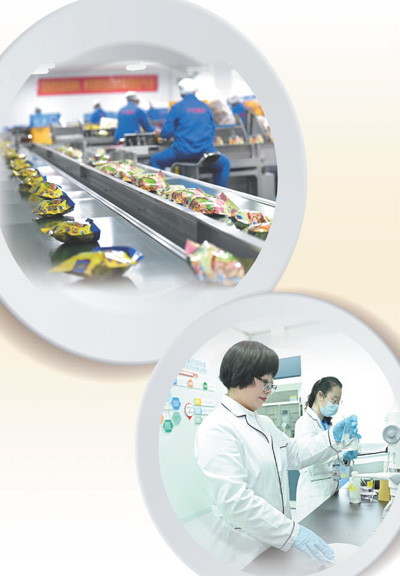River snail rice noodles transformed into major industry
To foodies, river snail rice noodles (or luosifen in Chinese) are known for being smelly but tasty. But what’s less well known is that Liuzhou, a major production base of luosifen in south China’s Guangxi Zhuang Autonomous Region, has turned the specialty into a lucrative industry by continuously advancing supply-side structural reform.

Luosifen (File photo)
Luosifen is often boiled with pickled bamboo shoots, pickled cowpeas, edible fungus, peanuts, dried bean curd sticks, and fresh vegetables in spiced river snail soup.
“Xihuanfeizai” is a luosifen restaurant in Liuzhou that has been around for 30 years. Open 19 hours a day, it sells an average of 3,000 bowls of luosifen each day, according to shop owner Chen Muhua.
“Our shop has become increasingly popular in recent years, and some of our patrons even hosted livestream sessions while enjoying our luosifen,” Chen noted, revealing that they have opened 30 chain restaurants outside Liuzhou, such as Nanning in Guangxi, and Lanzhou in northwest China’s Gansu province.
During the May Day holiday, luosifen restaurants became must-go places for tourists visiting Liuzhou. Statistics indicated that the city received 2.71 million tourists from May 1 to 5, more than any other city in the autonomous region. “Luosifen has made Liuzhou a hot destination for tourists,” according to a report on May Day holiday travel by the city’s administration of culture, radio and television and tourism.
At an industrial park invested by a luosifen manufacturer called “Luobawang”, one self-service restaurant has become a tourist attraction where people can not only get a taste of some delicious luosifen, but also watch the process of how luosifen is packaged.
“With a total investment of 450 million yuan and a factory area of 48,000 square meters, the industrial park produces 1.5 million bags of luosifen per day,” said Yao Hanlin, president of Luobawang. The park has been visited by about 300 primary and middle school students each day since it went into operation at the end of March.
“In 2015, I opened my first luosifen factory with an investment of 680,000 yuan. The 400-square-meter factory, which I rented, had a daily production capacity of 2,000 bags of luosifen. Five years later in 2020, the sales volume of our company has exceeded 900 million yuan. This is quite beyond my imagination,” Yao said.
“Thanks to the stay-at-home economy, which started to thrive during the outbreak of the COVID-19 epidemic last year, the number of orders we received have soared,” Yao added.
Last year, Liuzhou earned 10.9 billion yuan from packaged luosifen, up 75.74 percent year on year. Meanwhile, the city exported 30.38 million yuan worth of packaged luosifen, 35 times that of 2019. The city had 113 companies engaged in producing packaged luosifen, compared with only one in 2014. Nationwide, the number of luosifen restaurants has reached 18,000 compared with 5,000 10 years ago.
In May 2021, the cooking method for luosifen was included on the Fifth National List of Representative Elements of Intangible Cultural Heritage of China. .
Ten years ago, before Liuzhou luosifen had started to gain fame nationwide, Chen Wei, who is now the vice acting chairman of the Luosifen Association in Liuzhou, opened a luosifen restaurant in Beijing as part of a project to promote the dish in Beijing.
At the beginning, business was good, but later it started to lose money because there were insufficient profit growth points, and rental costs were high. “Back then, there was no packaged luosifen, which was easier to cook, so we had to boil the rice noodles one bowl after another,” Chen recalled. In 2016, the restaurant closed down.

A corner of a packaged Luosifen manufacturer’s workshop in Liuzhou. (Photo/Li Hanchi)
In May 2012, luosifen was featured in the highly acclaimed food documentary "A Bite of China". In the same year, Liuzhou held a luosifen festival, inviting tens of thousands of people to enjoy the dish together.
“The rise of social media platforms, including Weibo and WeChat, has brought greater fame to luosifen, and with the help of e-commerce platforms, luosifen has been sold to more places around the country,” Chen said.
In 2011, Yan Zhenhua, owner of a souvenir shop, started to make packaged luosifen. To make sure the packaged rice noodles taste as good as those freshly cooked in restaurants, he contacted multiple manufacturers until he found one that could meet his standards.
Two years later, while planning to set up a luosifen factory, he encountered challenges in applying for a permit for food production as luosifen didn’t belong to any of the categories of food that existed at the time, meaning there was a blank regarding the standards the food had to meet.
Then Yan and his partners decided to tackle the problem of market entrance. After repeated trials, and having the sample products checked again and again by quality control organizations, they were finally granted the first permit for packaged luosifen production in Liuzhou in October 2014.
Currently, the production of packaged luosifen has a comprehensive set of standards to follow. Yan’s company, while satisfying all relevant standards, has managed to extend the shelf life of packaged luosifen from 3 months to 6 months.
In recent years, Liuzhou has built luosifen industrial parks, characteristic towns and e-commerce parks, attracting more than 100 companies in the fields of raw material supply, processing, e-commerce, and logistics and delivery.
The luosifen raw material base in Liuzhou, covering more than 500,000 mu (33,333 hectares), has increased incomes for about 200,000 farmers. Qin Baolin is head of an agriculture company that supplies vegetables for a luosifen company. “This year, we’ve received orders with a total value of 200 million yuan,” said Qin.
The first packaged luosifen company in Liuzhou was established at the end of 2014, and only six years later, city lifted the industry’s output to 11 billion yuan ($1.7 billion) in 2020.
Photos
Copyright © 2021 People's Daily Online. All Rights Reserved.










